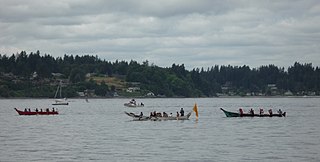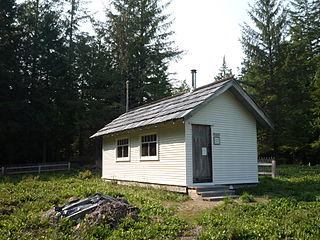
Neah Bay is a census-designated place (CDP) on the Makah Reservation in Clallam County, Washington, United States. The population was 935 at the 2020 census. It is across the Canada–US border from British Columbia. Europeans originally called it "Scarborough Harbour" in honor of Captain James Scarborough of the Hudson's Bay Company. It was changed to Neah in 1847 by Captain Henry Kellett. Kellett spelled it "Neeah Bay". The name "Neah" refers to the Makah Chief Dee-ah, pronounced Neah in the Klallam language. During the summer months, Neah Bay is a popular fishing area for sports fishermen. Another attraction is the Makah Museum, which houses artifacts from a Makah village partly buried by a mudslide around 1750. Many people also visit to hike the Cape Trail or camp at Hobuck Beach. An emergency response tug is stationed at Neah Bay which has saved 41 vessels since its introduction in 1999.

The Makah are an Indigenous people of the Pacific Northwest Coast living in Washington, in the northwestern part of the continental United States. They are enrolled in the federally recognized Makah Indian Tribe of the Makah Indian Reservation, commonly known as the Makah Tribe.

The Quileute are a Native American people in western Washington state in the United States, with 808 enrolled members as of 3/14/2018. They are a federally recognized tribe: the Quileute Tribe of the Quileute Reservation.

The Chimakum, also spelled Chemakum and Chimacum Native American people, were a group of Native Americans who lived in the northeastern portion of the Olympic Peninsula in Washington state, between Hood Canal and Discovery Bay until their virtual extinction in 1902. Their primary settlements were on Port Townsend Bay, on the Quimper Peninsula, and Port Ludlow Bay to the south.

Taro is a root vegetable. It is the most widely cultivated species of several plants in the family Araceae that are used as vegetables for their corms, leaves, stems and petioles. Taro corms are a food staple in African, Oceanic, East Asian, Southeast Asian and South Asian cultures. Taro is believed to be one of the earliest cultivated plants.

Wakashan is a family of languages spoken in British Columbia around and on Vancouver Island, and in the northwestern corner of the Olympic Peninsula of Washington state, on the south side of the Strait of Juan de Fuca.

La Push is a small unincorporated community situated at the mouth of the Quillayute River in Clallam County, Washington, United States, in the western Olympic Peninsula. La Push is the largest community within the Quileute Indian Reservation, which is home to the federally recognized Quileute tribe. La Push is known for its whale-watching and natural environment. The community has historically been located on the coast; however, sea level rise led the community to begin managed retreat to higher grounds in 2017.

Makah Reservation is an Indian reservation of the Makah Native Americans located on the northwestern tip of the Olympic Peninsula in Clallam County, Washington, United States. The northern boundary of the reservation is the Strait of Juan de Fuca. The western boundary is the Pacific Ocean. It has a land area of 121.451 square kilometres (46.892 sq mi) and a 2000 census resident population of 1,356 persons. Its largest community is Neah Bay.

A sweet onion is a variety of onion that is not pungent. Their mildness is attributable to their low sulfur content and high water content when compared to other onion varieties.

Agriculture in Cuba has played an important part in the economy for several hundred years. Today, it contributes less than 10% to the gross domestic product (GDP), but it employs about 20% of the working population. About 30% of the country's land is used for crop cultivation.

The almond potato, also called Mandel potato or Swedish peanut fingerling, is a potato known since the 19th century. Almond potatoes are yellow or white; in rare cases a variety called blue almond can be found which has yellow-white flesh with blue skin. Its shape is oval and somewhat resembles an almond, hence the name. Blue almond is an old variety which was grown in the northern regions of Sweden before the yellow-peeled almond potato was introduced.

The Intertribal Canoe Journey is a celebrated event of the Indigenous peoples of the Pacific Northwest Coast. Organizers call it the Canoe Journey or Intertribal Canoe Journey, and colloqually Tribal Journeys. It is also referred to by its destination, i.e. Paddle to Muckleshoot.

Washington, officially the State of Washington, is the northernmost state in the Pacific Northwest region of the United States. It is often referred to as Washington state to distinguish it from the national capital, both named for George Washington. Washington borders the Pacific Ocean to the west, Oregon to the south, Idaho to the east, and shares an international border with the Canadian province of British Columbia to the north. The state was formed from the western part of the Washington Territory, which was ceded by the British Empire in the Oregon Treaty of 1846. It was admitted to the Union as the 42nd state in 1889. Olympia is the state capital, and the most populous city is Seattle.

Helmi Dagmar Juvonen was an American artist active in Seattle, Washington. Although she worked in a wide variety of media, she is best known for her prints, paintings, and drawings. She is associated with the artists of the Northwest School.

Agriculture in Spain is important to the national economy. The primary sector activities accounting for agriculture, husbandry, fishing and silviculture represented a 2.7% of the Spanish GDP in 2017, with an additional 2.5% represented by the agrofood industry.

The Peter Roose Homestead is a historic homestead in the U.S. state of Washington that was settled by Peter Roose, an immigrant from Bollnäs, Sweden, in 1907. Located in Olympic National Park, the site was added as a historic district to the National Register of Historic Places in 2007.

In North Korea, the cultivation of potatoes is an important aspect to the livelihood of the country's population. The crop was introduced into the country in the early 1800s. Since the famine of the 1990s, a potato revolution has taken place. Over ten years, the area of potato cultivation in North Korea quadrupled to 200,000 hectares and per capita consumption increased from 16 to 60 kilograms per year.
Edward Eugene Claplanhoo was an American Makah elder and former chairman of the Makah Tribe, located on the northwest tip of the Olympic Peninsula in Washington state. Claplanhoo was the first Makah to earn a bachelor's degree. Claplanhoo was the chairman of the Makah during the excavation of the Ozette Indian Village Archeological Site in the 1970s. He is credited with keeping the artifacts uncovered at Ozette in Neah Bay. Under his leadership, the Makah Museum, which houses the Ozette collection, was established at Neah Bay in 1979. He also established Fort Núñez Gaona–Diah Veterans Park in Neah Bay in 2008.
Richard Deo Daugherty was an American archaeologist and professor, who led the excavation of the Ozette Indian Village Archeological Site in Washington state during the 1970s. The Ozette Indian Village, which was buried and preserved in a mudslide in the 1700s, has been called "the most significant archaeological dig of the 20th century" in the Pacific Northwest. Daugherty collaborated closely with the Makah during the dig, which uncovered more than 55,000 artifacts.

Sweet potato cultivation in Polynesia as a crop began around 1000 AD in central Polynesia. The plant became a common food across the region, especially in Hawaii, Easter Island and New Zealand, where it became a staple food. By the 17th century in central Polynesia, traditional cultivars were being replaced with hardier and larger varieties from the Americas. Many traditional cultivars are still grown across Polynesia, but they are rare and are not widely commercially grown.



















